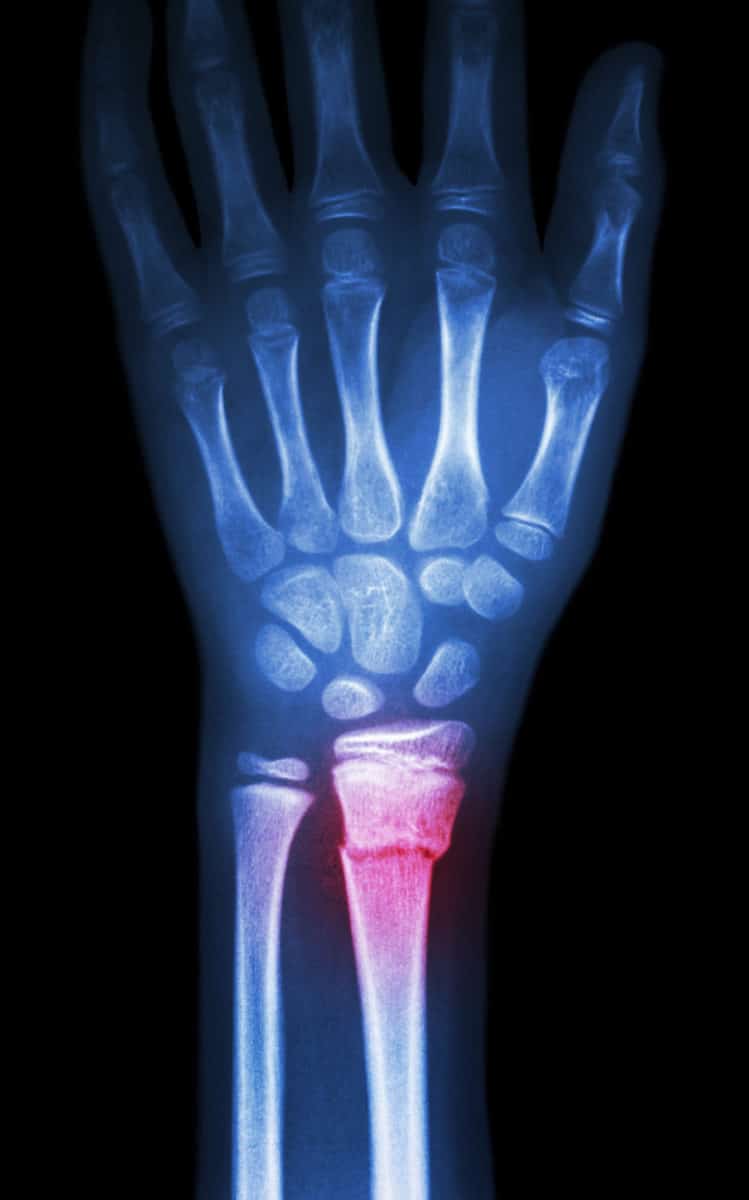Radius Fractures
Distal Radius Fracture Treatment
Home » Conditions » Fractures » Radius Fractures
Radius fractures are unfortunately common in many adults, especially older adults. The distal radius fracture (wrist fracture) in particular is the most common radius fracture. In fact, they occur more often than most other types of fractures. For individuals of all ages, a hard fall presents a significant risk of a distal radius fracture. Generally, we put our hands out in front of us to break our fall, but this sudden blow to the bones often results in damage. Other sources of these fractures are trauma from vehicle accidents or sports injuries. The best way to determine the severity of your injury is to visit a Dallas orthopedic surgeon.
At SPORT Orthopedics and Rehabilitation, we specialize in Dallas and Frisco fracture surgery. No matter how you sustained your injury, we’ll work with you every step of the way to facilitate a speedy and comfortable recovery. For more information about the treatments we offer, or to work with a Dallas physical therapist, please call our office at 469-200-2832 today.
Radius Fracture Symptoms
Distal radius fractures can be rather visible in many cases, resulting in wrist deformity and/or significant edema. Other signs and symptoms might be modest and be mistaken for a minor injury such as a sprain. Additional symptoms include the following.
- Sharp and immediate wrist pain at the exact moment of the fall, sometimes coupled with a sound or feeling of a snap
- Swelling and tenderness of the wrist which worsens over time
- Deformity around the wrist and forearm
- Numbness or difficulty/inability to move the hand or wrist
- Inability to grip or squeeze items
- Bruising of the wrist and forearm
What Is a Distal Radius Fracture?
On the thumb side of the forearm, the radius is one of two forearm bones. The distal radius is the portion of the radius that connects to the wrist joint. A distal radius fracture occurs when the radius breaks near the wrist. The most common cause of a break is falling on an extended or flexed hand. It can also occur as a result of a vehicle accident, a bike accident, a skiing accident, or another sporting event.
There are no additional fractures involved when a distal radius fracture is isolated. It can also happen in conjunction with a distal ulna fracture (the forearm bone on the small finger side). The injury is known as a distal radius and ulna fracture in these situations.
The fracture is classified as a Colles or Smith fracture depending on the angle at which the distal radius fractures.

Types of Distal Radius Fractures
- Colles: Direct impact to the palm, such as when you use your hands to break up a fall and land on your palms, can cause a Colles fracture. The form of a fork looking down is frequently compared to the side view of a wrist following a Colles fracture. The wrist has a noticeable “bump” in it, comparable to the fork’s neck. The fractured end of the distal radius moves up toward the rear of the hand, causing this.
- Smith: The Smith fracture is the less common of the two types of fractures. An impact to the rear of the wrist, such as falling on a bent wrist, can cause it. In this form of fracture, the distal end of the radius usually slips down toward the palm side. This generally results in a noticeable dip in the wrist where the radius’s larger portion terminates.
How Painful is a Distal Radius Fracture?
There are certain fractures that are more serious than others. Fractures that cause the smooth joint surface to split apart or fractures that shatter into numerous fragments (comminuted fractures) might render the bone unstable. These sorts of severe fractures frequently need surgery to correct and maintain their alignment. When a bone fragment fractures and is pushed out through the skin, it is called an open fracture. An increased risk of infection in the bone might result as a result of this.
In other words, the worse the fracture is, the more pain you’re likely to experience. Keep in mind that the pain tolerances and physiological differences between people vary greatly. A broken bone almost always hurts, but the level of pain varies both from patient to patient and depending on how severe the break is.
Radius Fracture Treatment
The first step to determining the proper treatment for your injury is to see an orthopedic specialist in Dallas. It may be feasible to wait until the next day to visit a doctor if the injury is not particularly painful and the wrist is not distorted. A splint can be used to protect the wrist. The wrist can be treated with an ice pack and raised until it can be examined by a doctor. It is important to go to the emergency room if the damage is severe, the wrist is distorted or numb, or the fingers are not pink.
The doctor will request wrist X-rays to confirm the diagnosis. The most popular and commonly used diagnostic imaging method is X-rays. X-rays can reveal if a bone is fractured and whether it has been displaced (a gap between broken bones). They can also indicate how many fractured bones are present.
How is a Radius Fracture Treated?
Broken bones are treated in the same way as other shattered bones: the broken parts must be repositioned and kept from moving until they mend. A distal radius fracture can be treated in a variety of ways. Many factors influence your decision, including the form of the fracture, your age and degree of exercise, and the surgeon’s personal preferences.
Nonsurgical Treatment
A plaster cast may be used until the damaged bone heals if it is in a favorable location. It may be essential to re-align the fractured bone fragments if the position (alignment) of your bone is out of place and likely to restrict your arm’s future usage. The precise name for the technique in which the doctor replaces the damaged parts is “reduction.” A closed reduction occurs when a bone is straightened without having to make an incision in the skin.
A splint or cast may be applied to your arm when the bone has been appropriately positioned. For the first few days, a splint is generally worn to allow for some natural swelling. After the swelling has subsided, a cast is generally applied a few days to a week later. The cast is replaced after 2 or 3 weeks when the edema subsides and the cast loosens.
Your doctor may take frequent x-rays to closely monitor the healing process, depending on the severity of the fracture. X-rays may be done at weekly intervals for 3 weeks and then at 6 weeks. If the fracture has not been reduced and is believed to be stable, X-rays may be performed less often.
About 6 weeks after the fracture, the cast is removed. Physical therapy is frequently started at this time to assist rehabilitate the damaged wrist’s mobility and function.
Surgical Treatment
The location of the bone can sometimes be so far out of place that it cannot be rectified or maintained in a cast. This might jeopardize your arm’s ability to function in the future. Surgery may be necessary in this situation.
In order to restore alignment, surgery usually entails creating an incision to directly access the fractured bones (open reduction). There are a variety of methods for keeping the bone in the proper position as it heals, depending on the kind of fracture.
- Cast
- Stainless steel or titanium metal pins
- Plates and screws
- External fixator, which is a frame outside the body to stabilize the area so it can heal
- A combination of the prior techniques
All open fractures require surgery as soon as possible (within 8 hours after damage). Antibiotics may be administered to prevent infection when the exposed soft tissue and bone are completely cleansed (debrided). To keep the bones in place, external or internal fixation techniques will be employed. Your doctor may use a temporary external fixator if the soft tissues around the fracture are significantly injured. Internal fixation with plates or screws may be used several days later in a second operation.
How Long Does it Take for a Radius Fracture to Heal?
Most people undergo the recovery process for at least a year. The process usually begins with pain management, using the RICE technique coupled with other recommendations from your surgeon. They might also recommend pain medications. Additionally, you must remain diligent in your cast and wound care. The most important recommendation is to keep your cast and incisions as clean and dry as possible. Once your surgeon gives you the green light, you will likely participate in physical therapy to restore your range of motion as best you can.
For the first year, some pain with intense exercises is to be expected. For high-energy injuries (such as motorcycle collisions), patients over 50 years of age, or patients with osteoarthritis, some residual stiffness or soreness is to be expected for at least two years, if not forever. The stiffness, on the other hand, is generally modest and has no impact on the arm’s overall function.
Finally, many wrist fractures are caused by osteoporosis. It has been proposed that patients with wrist fractures be evaluated for bone weakening, particularly if they have other osteoporosis risk factors. Inquire about osteoporosis testing with your doctor.
Distal Radius Fracture Treatment in Dallas & Frisco
At SPORT Orthopedics and Rehabilitation, we provide bone fracture treatment in Dallas for a number of different injuries. No matter how mild or severe your injury, we have a solution for you. While utilizing top-of-the-line medical techniques and technologies, we work with our patients every step of the way to get you back to living your active lifestyle. For more information about our treatment plans, or to schedule an appointment with an orthopedic specialist, please call 469-200-2832 today.


